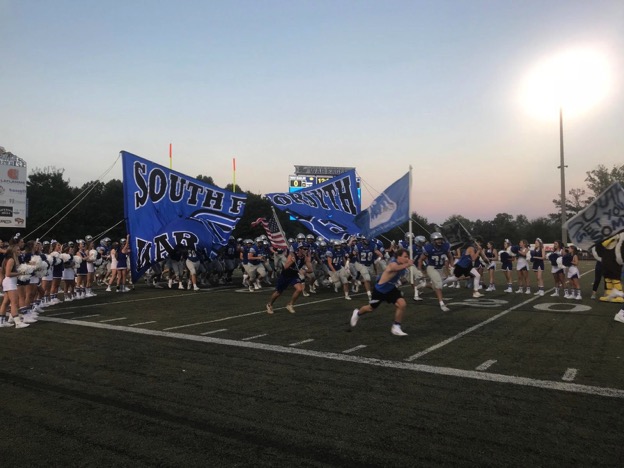Concussions in south athletes and beyond
South Forsyth players burst onto the field filled with cheerleaders, Blue Crew Posse (BCP) members, and the South Forsyth mascot ahead of their game against Lassiter.
October 16, 2017
Interceptions, goals, and home-runs all have something in common. Sports. The best feeling is when you are in a stadium watching your favorite team play, listening to fans cheering and announcers commentating. Millions of people play sports every day, whether for fun or as an occupation. This way of life has a hidden disadvantage though, one that has the ability to end lives. Concussions significantly impact athletes and although they are difficult to avoid, sports leagues in recent years have been revising rules in order to protect their players. Young athletes, high school athletes, and even professional athletes suffer from concussions and the consequences of multiple cranial impacts.
What is a concussion? Most people think it is a hard hit to the head, and although they are right, there is still much more to it. Concussions are brain injuries caused by hard hits to the head that temporarily alter an individual’s mental capacity. Symptoms include forgetfulness, inability to concentrate, headache, tiredness, and dizziness.
“After my first concussion, I couldn’t even do math without getting a headache” says South student Parker Disraeli. Parker played football, baseball, lacrosse, and now participates in wrestling. Symptoms usually last for about ten days to a month or two, but these are for minor cases.
After asking Daryn Rogers how long he was out for his concussion he responded, “About a week”. Daryn is a junior at South and plays running back and linebacker. The smaller cases last for smaller amounts of time, making it easier for players to return to their sport.
Serious cases may result in the alteration of physical, mental, and emotional behavior. “I got knocked out for 20 seconds and even to this day, I cannot remember anything that happened earlier,” Parker said. Policies require that if a player is showing signs of a concussion, which Parker did, the coach must remove them from the game and be taken to a hospital.
The contact from tackles, drills, and collisions with equipment is the leading cause of concussions in athletes. “It was ninth grade and I was tackling somebody, and I hit my head on the ground” says South football player, Jake Nitowski. Jake is a senior at South and plays offensive and defensive lineman.
An estimated 1.6-3.8 million athletes get concussions every year. Football is the sport most effected by concussions. Football accounts for about 60 percent of the concussions in athletes. Leagues are becoming more aware and have developed new rules that have produced declining concussion rates over the past years. In 1976, the National Collegiate Athletic Association prohibited any future head on head tackles in the sport. Football isn’t the only sport prone to these injuries, however. Soccer, baseball, hockey, and basketball have many recorded cases of the injury as well. Athletes must further educate themselves on the consequences of the injury, so that they can exercise caution both on and off the field.
A common long term consequence of multiple head injuries is Chronic Traumatic Encephalopathy (CTE).The most well-known athletes have suffered from CTE. This disease is found commonly in athletes, veterans, and other individuals who have experienced head trauma. It occurs when a protein begins to clump in the brain which slowly eats away brain cells. The illness has been discovered in people as young as 17 but it is likely people will not develop symptoms until several years after the trauma. Symptoms include depression, impulsive control problems, aggression, and paranoia. As time goes progresses, some victims suffer from memory loss, confusion, and impaired judgement. The symptoms differ for each person, but common symptoms may be difficult to control from the onset of the disease. Others may remain stable for years before their condition suddenly worsens. The more troubling aspect of this illness is that there is no cure and it cannot be diagnosed until death. This is life threatening, and multiple athletes have committed murders and suicides as a result of severe symptoms.
Chris Benoit, Terry Long, and Ryan Freel are of a selective few victims that have survived for a period of time with CTE. It may surprise you that some of your favorite athletes may suffer from this traumatic illness in their future. Ryan Freel, is an outfielder, and a second and third baseman for five different teams. Freel acquired many injuries from chasing fly balls since some hit him in the head. Freel is well-known for his ability to play multiple positions, but he is the first baseball player to be diagnosed with CTE. He had a fairly short career due to multiple injuries. In 2012, about two years after retiring, Freel committed suicide. When his brain was studied at Boston University, it was discovered by medical professionals that years of head injuries had caused Freel to develop CTE. Terry Long is a right guard for the Pittsburg Steelers who has also suffered from CTE. Terry long was the first professional football player to commit suicide. Terry Long played for only eight seasons, another tragic career cut short. Long tried to commit suicide in 1991 after testing positive for drugs. Then in 2005, Long committed suicide and his brain was studied for science. They found CTE in his brain as well. Chris Benoit was a Canadian wrestler. Benoit had one of the most severe case of CTE ever studied. The 40 year old wrestler killed his wife and son, then committed suicide. When studies on his brain commenced after the suicide and murders, doctors unsurprisingly discovered that his brain had matured so that it resembled an 80 year old brain. Thus, the findings exposed the reason for violent outbursts that had been emitted from Benoit at 40. Almost all of CTE cases end in death. CTE is no joke since people die as a result of this disease. Athletes need to understand that not taking proper precautions in sports will lead to multiple concussions, resulting in CTE.
Athletes must realize that reckless playing will take a toll on their brain. Sports are exhilarating, but the athletes should continue taking proper precautions to avoid harm. Most leagues have provided athletes with protective helmets and rules that protect player’s heads. High School athletes must continue to take part in what they enjoy while ensuring they stay safe and protected.





